Evidence-based plants for green infrastructure
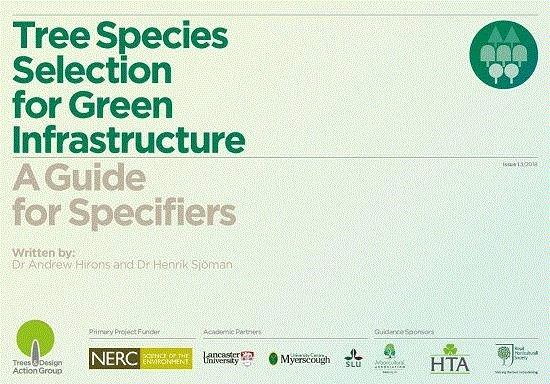
I’ve been looking forward to sharing this work by Dr. Andrew Hirons, Myerscough College (UK), and Dr. Henrik Sjöman, Gothenburg Botanical Gardens (Sweden), for months. There’s a great new database of 280 trees for use by tree specifiers of urban green infrastructure. While the database is UK and EU-centric, the principles upon which it’s based are very interesting and have implications for the entire nursery supply and landscape design, install and maintenance industry.
The Tree Species Selection for Green Infrastructure—A Guide for Specifiers has been published courtesy of The Trees and Design Action Group (TDAG). In it you’ll find 280 different trees searchable by their use, size and crown characteristics. It’s meant to serve as a living reference for green infrastructure specifiers: arboriculturists, designers, landscape architects, etc. The guide is to be a living document, informed by the experience of the users and bolstered as new information is available.
While it’s based on European work, the concepts Andrew and Henrik discuss in the seminar link below can inform work in the U.S. and Canada, too. The premise: Leverage the plant and its ecological characteristics with the site to create performance landscapes with trees.
The seminar "Species Selection Guide for Green Infrastructure" given by Andrew and Henrik late last spring is a worthy way to spend an hour and a half over several lunch breaks. A couple of the most interesting points follow without the specific detail provided by Andy and Henrik.
Looking for urban trees that perform? Think pioneers.
One of the main points of the presentation is to understand the tree’s position in ecological succession. Before specifying plants, ask where the site stands in terms of ecological succession. Will the tree be required to compete with other plants and weeds? How much water (root space) will it have access to?
A tree has to either maximize water acquisition or reduce water use. Species that avoid drought may close stomata, reduce leaf growth, shed leaves, etc. Avoid specifying “drought avoiders” for challenging sites; they typically lose their leaves. Instead look to species that have learned to tolerate water deficit. The guide includes research of how species rank for physiological drought tolerance.
Drought-sensitive species planted into constrained conditions with no root space will not perform well. In that situation, think about a deep-rooting tree.
Pioneer trees and shrubs successfully compete with weeds. Pioneer species hold a lot of potential for use as green infrastructure plants in difficult urban settings. Henrik points out that one strategy pioneer plants employ is to send roots deeply into the soil, penetrating below shallower soil levels, thus insuring their success due to better water access. Above ground, they may experience extreme temperature fluctuations, wind and sunlight, but the plants evolved physiological structure to take the stress. Species that come into the succession process later, such as understory trees, require the protected environment created by the overstory.
The pair pointed out that over and over again they see trees planted in site situations where the species didn't stand a chance because of its position in ecological succession.
Another issue is that plant specifiers tend to rely on too few species that they know well. We need more species, Henrik said. “It’s true around the world. Two to three species account for more than half of the tree population [in a given city],” a rote process that is “stupid and very dangerous.”
“The new generation of plant hunting will be pinpointing different ecotypes to really find the ones for urban environments. When it comes to genetic material, [I am] not sure the best is there now in public/botanic gardens. [There’s] more to be collected,” Henrik said.
_______________________________________________________________________

How America Uses its Land
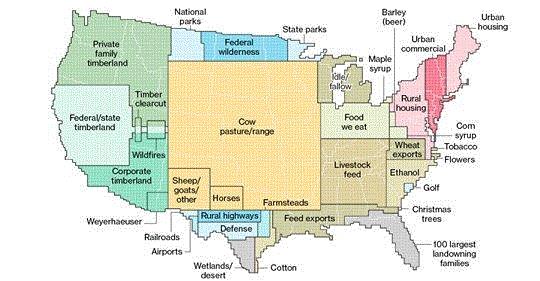
Bloomberg published a compelling interactive infographic, "Here's How America Uses Its Land," by Dave Merrill and Lauren Leatherby earlier in the month. The captivating piece provides context to see how the United States puts its 1.9 billion acres of land to work. The data is imprecise, to 250,000 acre blocks, but gives a broad impression of how important various types of land use are compared to one another.
While agriculture (pastures especially) take up the largest part of the country, Bloomberg’s summary describing the infographic stated: “On a percentage basis, urban creep outpaces growth in all other land-use category.”
The U.S. is adding about 1 million acres a year to the urban category—that’s like adding a city the size of L.A., Phoenix and Houston combined. Take a look, it’ll give you great context.
______________________________________________________________________
Plant Atlantic—Salix candida Iceberg Alley
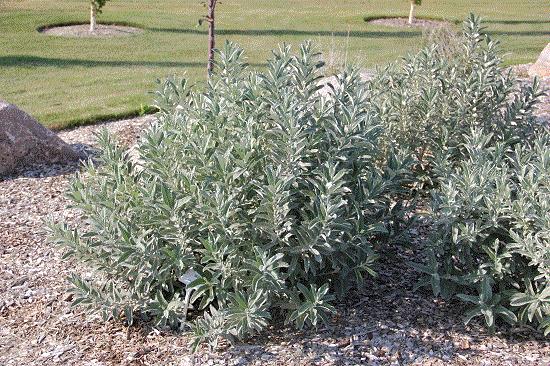
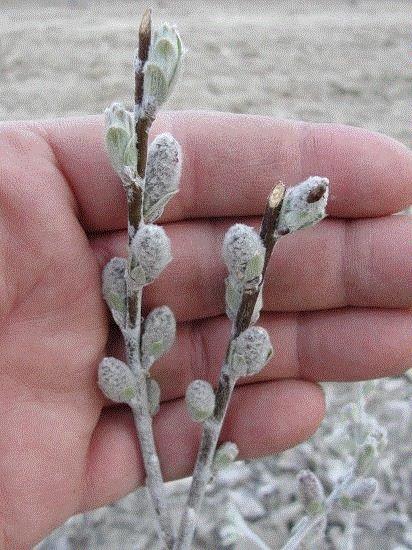
Salix candida Icebery Alley. Top photo shows compact habit. The photo above and below show buds and leaves. Photos courtesy of Jeffries Nurseries.
Plant Atlantic, a program to develop and market new hardy woody plant varieties based primarily on native Newfoundland flora, has been developed by Todd Boland, Memorial University of Newfoundland.
Salix candida, with a range of all of Canada and the northern tier of the United States, has been successfully introduced to the trade as a result. The trademark name Iceberg Alley will be used for release through the Northern Gardens Introduction program of Jeffries Nurseries in Manitoba and in the U.S. by Bailey in their First Editions program. The Zone 2 salt- and wind-tolerant shrub grows to a dwarf 3 to 4 ft. and has attractive silver foliage. Other natives Andromeda polifolia, Cotoneaster franchetii, Larix laricina and Picea abies have been shown to possess commercial potential and are under evaluation for introduction by Canadian nurseries.
Plant Atlantic was funded by the Canadian Ornamental Horticulture Alliance (COHA) with assistance from Agriculture and Agri-Food Canada’s (AAFC) AgriScience cluster program under the Growing II framework (April 1, 2013 to March 31, 2018).
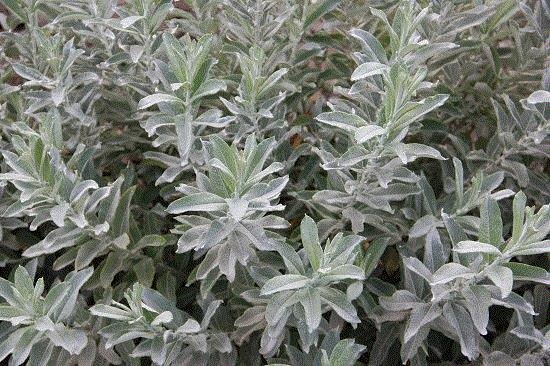
___________________________________________________________________

EPA’s Campus Rainworks Challenge
EPA has announced the 7th annual Campus RainWorks Challenge, a green infrastructure design competition open to colleges and universities across the country. Campus RainWorks Challenge seeks to engage with undergraduate and graduate students to foster a dialogue about stormwater management and showcase the environmental, economic and social benefits of green infrastructure practices.
Teams can register September starting 1, 2018; the deadline for entries is December 14, 2018. EPA will announce winners next spring. Questions may be sent to RainWorks@epa.gov
___________________________________________________________________
Go Outside: It’s Good for You
Living close to nature and spending time outside has significant and wide-ranging health benefits, according to new research from the University of East Anglia (UEA), Norwich, England. Exposure to greenspace reduces the risk of type II diabetes, cardiovascular disease, premature death, preterm birth, stress and high blood pressure.
Populations with higher levels of greenspace exposure are also more likely to report good overall health, according to global data involving more than 290 million people in 140 studies across 20 countries.
Lead author Caoimhe Twohig-Bennett, from UEA’s Norwich Medical School, said “We found that spending time in, or living close to, natural green spaces is associated with diverse and significant health benefits.
“People living closer to nature also had reduced diastolic blood pressure, heart rate and stress. In fact, one of the really interesting things we found is that exposure to greenspace significantly reduces people’s levels of salivary cortisol—a physiological marker of stress."
“People living near greenspace likely have more opportunities for physical activity and socializing. Meanwhile, exposure to a diverse variety of bacteria present in natural areas may also have benefits for the immune system and reduce inflammation. Much of the research from Japan suggests that phytoncides—organic compounds with antibacterial properties—released by trees could explain the health-boosting properties of forest bathing.”
—Excerpted from: "It’s official: Spending time outside is good for you," a press release from the University of East Anglia.
The health benefits of the great outdoors: A systematic review and meta-analysis of greenspace exposure and health outcomes by Caoimhe Twohig-Bennett and Andy Jones in Environmental Research.
______________________________________________________________________

New England Bees
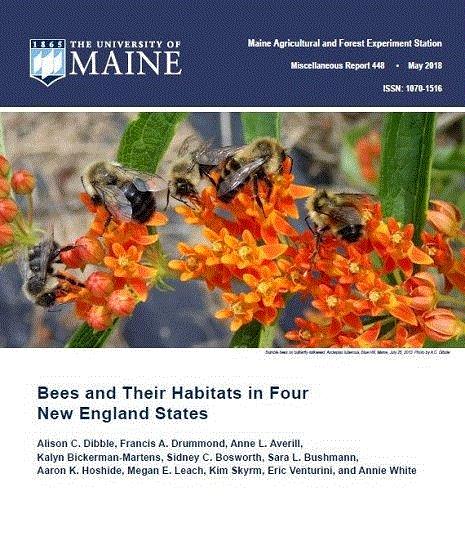
"Bees and Their Habitats in Four New England States," a new publication by Maine Cooperative Extension, includes previously unpublished information and a synthesis of literature relevant to Massachusetts, Maine, New Hampshire and Vermont. The report also offers recommendations for bee habitat improvement, summarizes new information about the economics of pollinator habitat improvements and identifies knowledge gaps to help prioritize future research directions.
Over 400 species of bees have been documented in these four states. Most are native to the region, but little is known about the ecology, life history, population dynamics and host plant relations for most species. Bees face threats from habitat loss, pests and pathogens, pesticides and climate change, and some species are in documented decline.
The publication lists 15 bee habitats with natural and anthropogenic features, and suggests 40 plant taxa that may be effective in plantings for bees. Potential habitat improvements noted in the publication include planting suitable flowers and mowing less intensively to improve food availability and minimizing pesticide use.
—From New publication about bees and their New England habitats available a University of Maine press release by Francis Drummond.
__________________________________________________________________
Online Viewing: The Garden as Haven
The American Horticultural Society has posted “The Garden as Haven: Finding Resilience and Renewal in Turbulent Times” online for viewing. The forum was held during the National Children & Youth Garden Symposium by AHS.
This forum was an opportunity for candid and thoughtful conversation about the changing realities of the educational environment and the ways garden spaces can be used not only to teach, but to lower stress, develop a sense of optimism and build a more resilient community.
Among the presenters: Marsha Guenzler-Stevens, University of Maryland; Kyle Jeter, Marjory Stoneman Douglas High School teacher, and Greg Eells, Cornell University.
___________________________________________________________________
Bird Migration Maps Back
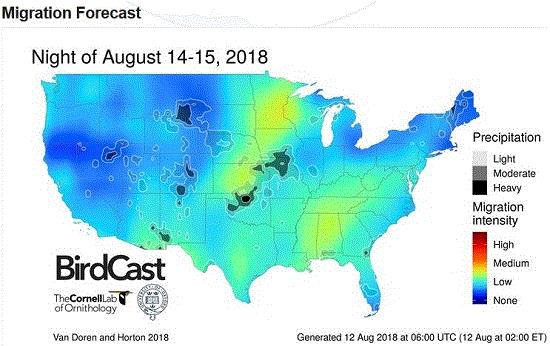
Starting August 1, Cornell’s Lab of Ornithology has reactivated their BirdCast maps providing a real-time look at bird migration. If you’d like to know what’s coming your way during the fall migration, bookmark the page.
___________________________________________________________________________
Worth Reading
Leveraging Landscape: Tools for Urban Resilience by Elizabeth Shreeve on Urban Land.
Islands of concrete keep Dallas temperatures well above what the weatherman reports by Janette K. Monear for Dallas News.
How landscapers can work with nature by Alessandro Carrara on Landscape Insight.
Commentary: Eco-gardening perspectives by Karen Pierson and Jan Brink on WickedLocal.
Could Houseplants Keep Tabs on the Health of Your Home? by Emily Matchar in the Smithsonian.
A small band of environmentalists takes fight against Obama Presidential Center to court by Lolly Bowean in the Chicago Tribune.
The Green Big Apple: New Yorkers document the city's plants by Emiliano Rodriguez Mega (AP) on Whig.com.
Instructor creates rest stops for bees in effort to save them by Kumasi Aaron on ABC Tampa WFTS.
How cities can work with nature when droughts take their toll by Kevin Winter and Peta Brom for The Conversation on ReliefWeb.
We have the new perennials but where is the new perennial garden? by Noel Kingsbury on Noel’s Garden Blog.
The world’s first “high-tech eco village” will reinvent suburbs by Adele Peters on FastCompany.com.
SCIENCE TO THE GROWER: Clearing the air by Richard Evans in University of California UCNFA News (see page 11).
Specialist Bee Plants from the Great Pollinator Project
Yes, Animals Really Use Tunnels and Bridges to Cross Roads by Sarah Holder on CityLab.
LA awarded $1.3 million to better understand how the drought and pests are threatening park trees by Elizabeth Chou on Los Angeles Daily News.
Containers with water can produce potentially deadly mosquitoes in the California Association of Nurseries and Garden Centers newsletter.
Hydrologic and water quality performance of permeable pavement with internal water storage over a clay soil in Durham, North Carolina by Alessandra S. Braswell, Ryan J. Winston and William F. Hunt in the Journal of Environmental Management.
Effect of Greening Vacant Land on Mental Health of Community-Dwelling Adults A Cluster Randomized Trial by Eugenia C. South, MD, MS; Bernadette C. Hohl, PhD; and Michelle C. Kondo, PhD; et al. on JAMA Network (open source)
The future is (hopefully) green by Sara McCrea in the Boulder Weekly.
Garden check: These 44 plants may soon be banned in Indiana by Amanda Mueller on TristateHomepage.com.
How an invasive plant is helping ticks survive by Abigail Curtis in the Bangor Daily News.
‘A Virtuous Cycle of Green’: How Street Design Can Be Calmed by Nature--Making Cascadia’s streets more like gardens ensures complete streets are green streets. by David Goldberg for Sightline.org.
Crows have consistent habits of partial migration, study shows by United Press International.
In Dallas’ Urban Heat Island, Planting Trees to Help Residents Breathe by Katelyn Newman in US News & World Report.
New study identifies bird migration stopover sites by Adam Thomas, University of Delaware press release.
Living Architecture Monitor Summer Issue: The Biophilic Design Issue
Growing Seattle Ups the Ante on Green and Complete Streets by David Goldberg for Sightline Institute.
The Rise of the Urban Rooftop by Laura Winkless for Forbes.
Best,

Debbie Hamrick
NewTerrain
This email was received by 19,986 readers.
If you're interested in advertising in NewTerrain, contact Kim Brown.